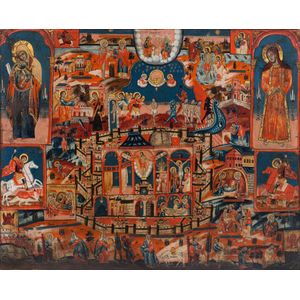Palestinian Proskynetarion: Rare Holy Land Pilgrim's Memento
A rare and important Palestinian School Proskynetarion or Pilgrim's Memento, comprising images of the Holy Sepulchre within the City of Jerusalem, and numerous holy personages and scenes from Scripture. circa 1800, painted on canvas; laid down on new canvas and reframed during the 20th century. 92 x 114 cm. Key to the Greenberg Proskynetarion. 1. The Virgin and Child. 2. The Lord Jesus Christ in the robes of a priest. 3. Saint George the Great Martyr. 4. Saint Demetrius the Great Martyr. 5. Symbol of Evangelist John. 6. Symbol of Evangelist Matthew. 7. Symbol of Evangelist Luke. 8. Symbol of Evangelist Mark. 9. Holy Mary of Egypt receives the Host from the Monk Zosima. 10. The Baptism of the Lord on the River Jordan. 11. The Annunciation of the Virgin Mary. 12. Mar Sabba and his Monastery. 13. Judas hanging from a tree. 14. The Holy Prophet Baruch sleeping in a garden. 15. The Blind Man healed at the Pool of Siloam. 16. The Dormition of the Virgin Mary. 17. The Nativity of the Lord in Bethlehem. 18. The Massacre of the Innocents. 19. The Holy Prophet Elijah fed by a raven in the wilderness. 20. The Port of Jaffa. 21. Patriarch Lot receives three branches of the Tree of Life from Holy Patriarch Abraham. 22. Patriarch Lot waters the Tree of Life. 23. The Devil waylays Patriarch Lot and demands a drink of water. 24. King Solomon commands a Cedar of Lebanon to be cut down to build the Temple. 25. Workmen carry away dressed cedar logs for the building of the Temple. 26. The Holy Trinity. 27. The Last Judgement and a Soul hangs in the Balance. 28. The Crucifixion. 29. The Entombment of Christ. 30. The Grotto of the Holy Sepulchre. 31. The Resurrected Christ rises above his Shrine, the Aedicula. 32. The Patriarch of Jerusalem receives two tapers of the Holy Fire from Angels. Joseph Greenberg Icons. When he was working in the UK in the 50s and 60s, Joseph Greenberg assembled a collection of icons and statuary from both the Orthodox and Catholic traditions. His motives for collecting in this field are not clear. He may have appreciated them in a similar manner to the African and Melanesian figures that were also 'on his radar' ? as appealing and exotic artefacts from distant lands. Their artistic and spiritual qualities may also have been an attraction. It is true that Byzantine iconography makes its way into some of his own paintings and collages. Collecting in this field fifty years ago was very different to what it is today. Things could be found in markets and antique stores that would never appear now. Icon painting was still an unusual, even an esoteric pursuit, a long way from being fashionable. Consequently, a person of moderate means, provided he or she had 'the eye' and a bit of luck, could still make very good acquisitions. As a result, the Greenberg collection includes some works of considerable interest. Most of the icons are from the Greek speaking world, but there are also some Russian, Coptic and Levantine images. Of special note is a large composite image dating to the end of the 18th century (see lot 9). Painted on canvas rather than the more usual wooden panel, this is a rare and important example of a Pilgrim's souvenir of the Holy Places, known in Greek as a Proskynetarion. Fewer than 150 of these survive, and most of these are in European collections. The purpose of a Proskynetarion was to provide the Pilgrim with a visual and devotional memento of the Christian Hajj ? the visit to the Holy Land specifically to witness the Miracle of the Holy Fire, celebrated at Orthodox Easter in the Church of the Resurrection (also called The Holy Sepulchre) in Jerusalem itself. Such images were almost all painted in workshops within the Holy City, and this is a particularly fine example. Almost every scene and figure contained within this painting relates to a specific place in or near Jerusalem that is mentioned in Scriptures; and which would therefore have formed part of the Pilgrim's itinerary during his or her stay in the H
You must be a subscriber, and be logged in to view price and dealer details.
Subscribe Now to view actual auction price for this item
When you subscribe, you have the option of setting the currency in which to display prices to $Au, $US, $NZ or Stg.
This item has been sold, and the description, image and price are for reference purposes only.
- Circa - A Latin term meaning 'about', often used in the antique trade to give an approximate date for the piece, usually considered to be five years on either side of the circa year. Thus, circa 1900 means the piece was made about 1900, probably between 1895 and 1905. The expression is sometimes abbreviated to c.1900.
This item has been included into following indexes:
- religious objects, Christian
- religious objects, Orthodox
